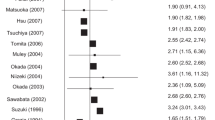Abstract
Background
The purpose of this study was to analyze the clinical significance of serum Sialyl Lewisx (SLX) concentrations as a predictor of N2 disease in patients with non–small-cell lung cancer.
Methods
The study included 272 patients with non–small-cell lung cancer who underwent pulmonary resection in our institution between January 1998 and December 2003. Of 272 patients, the serum concentrations of SLX were measured by using a commercially available radioimmunoassay kit.
Results
The 5-year survival rates of patients with concentrations of SLX > 38 U/mL and those with lower concentrations were 32% and 69%, respectively (P < .0001). The median serum concentration of SLX in patients with multilevel N2 or N3, single-level N2, and N0/1 disease were 44, 30, and 27 U/mL, respectively. The concentrations of serum SLX in patients with multilevel N2 disease were significantly higher than those in patients with single-level N2 or those with N0/1 disease (Mann-Whitney U-test; P < .0001). Although the sensitivity of SLX for identifying patients with non–small-cell lung cancer was only 24% in all patients, the sensitivity of SLX increased as the N-factor increased; the sensitivity of N0/1 disease was 15%, that of single-level N2 disease was 22%, and that of multilevel N2 or N3 disease was 71%.
Conclusions
High serum concentrations of SLX predicted multilevel N2 disease and the associated poor outcome. Although the sensitivity of serum SLX is not acceptable for use as a screening tumor marker, we suggest that the serum concentration of SLX is useful as a staging marker to determine the strategy of treatment.




Similar content being viewed by others
References
Mountain CF. Revisions in the International System for Staging Lung Cancer. Chest 1997; 111:1710–7
Vansteenkiste JF, De Leyn PR, Deneffe GJ, et al. Survival and prognostic factors in resected N2 non-small cell lung cancer: a study of 140 cases. Leuven Lung Cancer Group. Ann Thorac Surg 1997; 63:1441–50
Okada M, Tsubota N, Yoshimura M, Miyamoto Y, Matsuoka H. Prognosis of completely resected pN2 non-small cell lung carcinomas: what is the significant node that affects survival? J Thorac Cardiovasc Surg 1999; 118:270–5
Riquet M, Manac’h D, Le Pimpec-Barthes F, Dujon A, Chehab A. Prognostic significance of surgical-pathologic N1 disease in non-small cell carcinoma of the lung. Ann Thorac Surg 1999; 67:1572–6
Robinson LA, Wagner H Jr, Ruckdeschel JC. Treatment of stage IIIA non-small cell lung cancer. Chest 2003; 123:202–20
Ichinose Y, Kato H, Koike T, et al. Overall survival and local recurrence of 406 completely resected stage IIIa-N2 non-small cell lung cancer patients: questionnaire survey of the Japan Clinical Oncology Group to plan for clinical trials. Lung Cancer 2001; 34:29–36
Tanaka F, Yanagihara K, Otake Y, et al. Prognostic factors in resected pathologic (p-) stage IIIA-N2, non-small-cell lung cancer. Ann Surg Oncol 2004; 11:612–8
Sawabata N, Keller SM, Matsumura A, et al. The impact of residual multi-level N2 disease after induction therapy for non-small cell lung cancer. Lung Cancer 2003; 42:69–77
Ueda K, Kaneda Y, Sakano H, et al. Independent predictive value of the overall number of metastatic N1 and N2 stations in lung cancer. Jpn J Thorac Cardiovasc Surg 2003; 51:297–301
De Leyn P, Vansteenkiste J, Deneffe G, Van Raemdonck D, Coosemans W, Lerut T. Result of induction chemotherapy followed by surgery in patients with stage IIIA N2 NSCLC: importance of pre-treatment mediastinoscopy. Eur J Cardiothorac Surg 1999; 15:608–14
Friedel G, Hruska D, Budach W, et al. Neoadjuvant chemoradiotherapy of stage III non-small-cell lung cancer. Lung Cancer 2000; 30:175–85
Trodella L, Granone P, Valente S, et al. Neoadjuvant concurrent radiochemotherapy in locally advanced (IIIA-IIIB) non-small-cell lung cancer: long-term results according to downstaging. Ann Oncol 2004; 15:389–98
Fernando HC, Goldstraw P. The accuracy of clinical evaluative intrathoracic staging in lung cancer as assessed by postsurgical pathologic staging. Cancer 1990; 65:2503–6
Goldstraw P, Mannam GC, Kaplan DK, Michail P. Surgical management of non-small-cell lung cancer with ipsilateral mediastinal node metastasis (N2 disease). J Thorac Cardiovasc Surg 1994; 107:19–27
Moro D, Villemain D, Vuillez JP, Delord CA, Brambilla C. CEA, CYFRA21-1 and SCC in non-small cell lung cancer. Lung Cancer 1995; 13:169–76
Pujol JL, Molinier O, Ebert W, et al. CYFRA 21-1 is a prognostic determinant in non-small-cell lung cancer: results of a meta-analysis in 2063 patients. Br J Cancer 2004; 90:2097–105
Stieber P, Hasholzner U, Bodenmuller H, et al. CYFRA 21-1. A new marker in lung cancer. Cancer 1993; 72:707–13
Sugama Y, Kitamura S, Kawai T, et al. Clinical usefulness of CYFRA assay in diagnosing lung cancer: measurement of serum cytokeratin fragment. Jpn J Cancer Res 1994; 85:1178–84
Brechot JM, Chevret S, Nataf J, et al. Diagnostic and prognostic value of Cyfra 21-1 compared with other tumour markers in patients with non-small cell lung cancer: a prospective study of 116 patients. Eur J Cancer 1997; 33:385–91
Takamochi K, Nagai K, Suzuki K, Yoshida J, Ohde Y, Nishiwaki Y. Clinical predictors of N2 disease in non-small cell lung cancer. Chest 2000; 117:1577–82
Ando S, Kimura H, Iwai N, Kakizawa K, Shima M, Ando M. The significance of tumour markers as an indication for mediastinoscopy in non-small cell lung cancer. Respirology 2003; 8:163–7
Takada M, Masuda N, Matsuura E, et al. Measurement of cytokeratin 19 fragments as a marker of lung cancer by CYFRA 21-1 enzyme immunoassay. Br J Cancer 1995; 71:160–5
Bevilacqua MP, Pober JS, Mendrick DL, Cotran RS, Gimbrone MA Jr. Identification of an inducible endothelial-leukocyte adhesion molecule. Proc Natl Acad Sci USA 1987; 84:9238–42
Lowe JB, Stoolman LM, Nair RP, Larsen RD, Berhend TL, Marks RM. ELAM-1–dependent cell adhesion to vascular endothelium determined by a transfected human fucosyltransferase cDNA. Cell 1990; 63:475–84
Phillips ML, Nudelman E, Gaeta FC, et al. ELAM-1 mediates cell adhesion by recognition of a carbohydrate ligand, sialyl-Lex. Science 1990; 250:1130–2
Walz G, Aruffo A, Kolanus W, Bevilacqua M, Seed B. Recognition by ELAM-1 of the sialyl-Lex determinant on myeloid and tumor cells. Science 1990; 250:1132–5
Takada A, Ohmori K, Takahashi N, et al. Adhesion of human cancer cells to vascular endothelium mediated by a carbohydrate antigen, sialyl Lewis A. Biochem Biophys Res Commun 1991; 179:713–9
Berg EL, Magnani J, Warnock RA, Robinson MK, Butcher EC. Comparison of L-selectin and E-selectin ligand specificities: the L-selectin can bind the E-selectin ligands sialyl Le(x) and sialyl Le(a). Biochem Biophys Res Commun 1992; 184:1048–55
Bresalier RS, Ho SB, Schoeppner HL, et al. Enhanced sialylation of mucin-associated carbohydrate structures in human colon cancer metastasis. Gastroenterology 1996; 110:1354–67
Imada T, Rino Y, Takahashi M, et al. Serum CA 19-9, SLX, STN and CEA levels of the peripheral and the draining venous blood in gastric cancer. Hepatogastroenterology 1999; 46:2086–90
Nakagoe T, Sawai T, Tsuji T, et al. Predictive factors for preoperative serum levels of sialy Lewis(x), sialyl Lewis(a) and sialyl Tn antigens in gastric cancer patients. Anticancer Res 2002; 22:451–8
Ikeda Y, Mori M, Kajiyama K, Haraguchi Y, Sasaki O, Sugimachi K. Immunohistochemical expression of sialyl Tn, sialyl Lewis a, sialyl Lewis a-b-, and sialyl Lewis x in primary tumor and metastatic lymph nodes in human gastric cancer. J Surg Oncol 1996; 62:171–6
Nakagoe T, Kusano H, Hirota M, et al. Serological and immunohistochemical studies on sialylated carbohydrate antigens in colorectal carcinoma. Gastroenterol Jpn 1991; 26:303–11
Nakagoe T, Fukushima K, Hirota M, et al. Immunohistochemical expression of sialyl Lex antigen in relation to survival of patients with colorectal carcinoma. Cancer 1993; 72:2323–30
Tanaka K, Togo S, Nanko M, et al. Sialyl Lewis X expression in vascular permeating lesions as a factor for predicting colorectal cancer metastasis. Hepatogastroenterology 1999; 46:875–82
Yamaguchi A, Goi T, Seki K, et al. Clinical significance of combined immunohistochemical detection of CD44v and sialyl LeX expression for colorectal cancer patients undergoing curative resection. Oncology 1998; 55:400–3
Ogawa J, Tsurumi T, Yamada S, Koide S, Shohtsu A. Blood vessel invasion and expression of sialyl Lewisx and proliferating cell nuclear antigen in stage I non-small cell lung cancer. Relation to postoperative recurrence. Cancer 1994; 73:1177–83
Tsumatori G, Ozeki Y, Takagi K, Ogata T, Tanaka S. Relation between the serum E-selectin level and the survival rate of patients with resected non-small cell lung cancers. Jpn J Cancer Res 1999; 90:301–7
Mukae H, Hirota M, Kohno S, et al. Elevation of tumor-associated carbohydrate antigens in patients with diffuse panbronchiolitis. Am Rev Respir Dis 1993; 148:744–51
Yokoyama A, Kohno N, Kondo K, et al. Comparative evaluation of sialylated carbohydrate antigens, KL-6, CA19-9 and SLX as serum markers for interstitial pneumonia. Respirology 1998; 3:199–202
World Health Organization. Histological typing of lung and pleural tumours. In: Travis WD, Colby TV, Corrin B, Shimosato Y, Brambilla E, (eds). Collaboration with Pathologists in 14 Countries. 3rd ed. Geneva: World Heath Organization, 1999
Naruke T, Suemasu K, Ishikawa S. Surgical treatment for lung cancer with metastasis to mediastinal lymph nodes. J Thorac Cardiovasc Surg 1976; 71:279–85
Martini N, Flehinger BJ. The role of surgery in N2 lung cancer. Surg Clin North Am 1987; 67:1037–49
Oyama T, Kawamoto T, Matsuno K, et al. A case-case study comparing the usefulness of serum trace elements (Cu, Zn and Se) and tumor markers (CEA, SCC and SLX) in non-small cell lung cancer patients. Anticancer Res 2003; 23:605–12
Nishida K, Yamamoto H, Ohtsuki T, et al. Elevated tissue concentrations of sialyl Lex-i in cancerous tissues compared with those in noncancerous tissues of various organs. Cancer 1991; 68:111–7
Kawai T, Suzuki M, Kase K, Ozeki Y. Expression of carbohydrate antigens in human pulmonary adenocarcinoma. Cancer 1993; 72:1581–7
Stetler-Stevenson WG, Aznavoorian S, Liotta LA. Tumor cell interactions with the extracellular matrix during invasion and metastasis. Annu Rev Cell Biol 1993; 9:541–73
Folkman J. Tumor angiogenesis. Adv Cancer Res 1985; 43:175–203
Volm M, Koomagi R, Mattern J. PD-ECGF, bFGF, and VEGF expression in non-small cell lung carcinomas and their association with lymph node metastasis. Anticancer Res 1999; 19:651–5
O’Byrne KJ, Koukourakis MI, Giatromanolaki A, et al. Vascular endothelial growth factor, platelet-derived endothelial cell growth factor and angiogenesis in non-small-cell lung cancer. Br J Cancer 2000; 82:1427–32
Miyoshi T, Kondo K, Hino N, Uyama T, Monden Y. The expression of the CD44 variant exon 6 is associated with lymph node metastasis in non-small cell lung cancer. Clin Cancer Res 1997; 3:1289–97
Tran TA, Kallakury BV, Sheehan CE, Ross JS. Expression of CD44 standard form and variant isoforms in non-small cell lung carcinomas. Hum Pathol 1997; 28:809–14
Tokuraku M, Sato H, Murakami S, Okada Y, Watanabe Y, Seiki M. Activation of the precursor of gelatinase A/72 kDa type IV collagenase/MMP-2 in lung carcinomas correlates with the expression of membrane-type matrix metalloproteinase (MT-MMP) and with lymph node metastasis. Int J Cancer 1995; 64:355–9
Sasaki H, Yukiue H, Moiriyama S, et al. Clinical significance of matrix metalloproteinase-7 and Ets-1 gene expression in patients with lung cancer. J Surg Res 2001; 101:242–7
Tamura M, Oda M, Matsumoto I, et al. The combination assay with circulating vascular endothelial growth factor (VEGF)-C, matrix metalloproteinase-9, and VEGF for diagnosing lymph node metastasis in patients with non-small cell lung cancer. Ann Surg Oncol 2004; 11:928–33
Author information
Authors and Affiliations
Corresponding author
Rights and permissions
About this article
Cite this article
Mizuguchi, S., Inoue, K., Iwata, T. et al. High Serum Concentrations of Sialyl Lewisx Predict Multilevel N2 Disease in Non–Small-Cell Lung Cancer. Ann Surg Oncol 13, 1010–1018 (2006). https://doi.org/10.1245/ASO.2006.05.018
Received:
Accepted:
Published:
Issue Date:
DOI: https://doi.org/10.1245/ASO.2006.05.018




